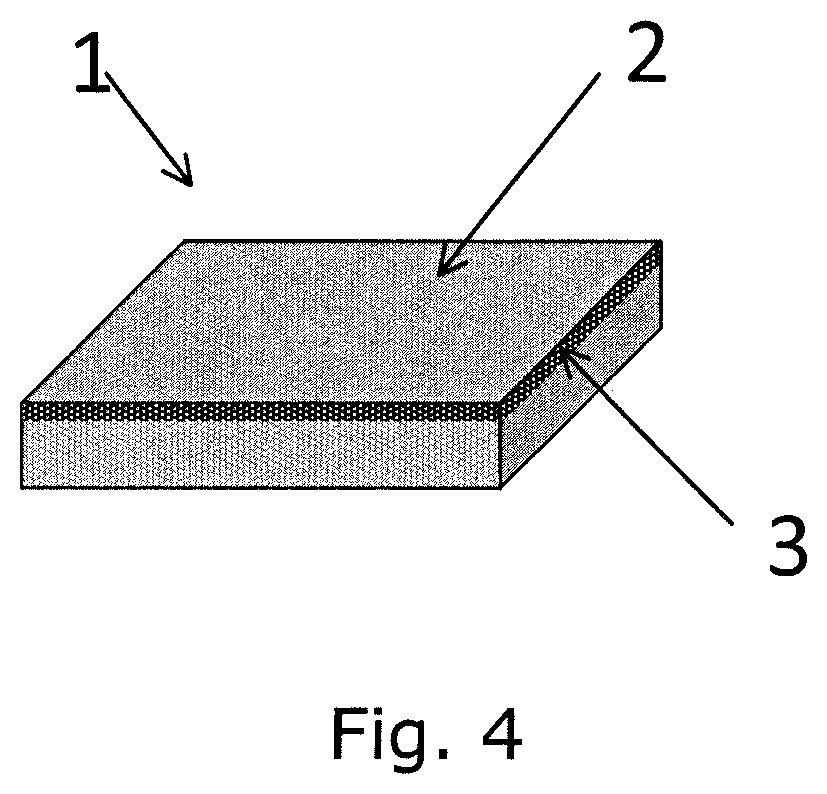Photocatalytic concrete product and a method to produce a photocatalytic concrete product
a photocatalytic concrete and concrete technology, applied in the direction of catalyst activation/preparation, physical/chemical process catalysts, separation processes, etc., can solve the problems of large amount of titanium dioxide powder used, affecting the colour of the final material as well as the material properties, and air pollution in open areas with motorized traffic,
- Summary
- Abstract
- Description
- Claims
- Application Information
AI Technical Summary
Benefits of technology
Problems solved by technology
Method used
Image
Examples
example 1
[0082]Commercial concrete pavement blocks 50×50 cm2, from Gammelrand Beton, were used to test the photocatalytic composition applied with spray nozzles on the not-yet-set concrete blocks. 100-150 g / m2 of photocatalytic dispersion (PD) was applied on each concrete block with a hydraulic nozzle system. The photocatalytic dispersion was a 1.5 wt % water-based TiO2 dispersion stabilized to pH 10-11 with ammonia including 42% diethylenglycol as humectant and 5% Disperbyk 191. The average particle size in the dispersions (measured by Volume with Nanotrac NPA 252) was measured to 22 nm. The pavement concrete blocks were sprayed and left for ambient drying for 72 hours. After 72 hours, the visual appearance of the photocatalytic pavement blocks were evaluated by comparing to commercial pavement concrete blocks, commercial concrete blocks sprayed with 100-150 g / m2 water, commercial pavement concrete blocks sprayed with a 1.5 wt % water based TiO2 dispersion similar to PD but without humectan...
example 2
[0086]50×50 cm2 commercial grey pavement stones (Gammelrand Beton) were used to test the photocatalytic activity of the photocatalytic composition applied to the not-yet-set concrete pavement stone. The photocatalytic composition applied with spray nozzles on the not-yet-set concrete blocks. 150 g / m2 of photocatalytic dispersion (PD) was applied on each concrete block with a hydraulic nozzle system. The photocatalytic dispersion was a 1.6 wt % water-based TiO2 dispersion stabilized to pH 10-11 with ammonia including 42% diethylenglycol as humectant and 5% Disperbyk 191. The average particle size (of TiO2) in the dispersions (measured by Volume with Nanotrac NPA 252) was measured to 22 nm. The final composition had a pH of 8. The pavement concrete blocks were sprayed and left for ambient drying for 72 hours. After 72 hours, the concrete block was cut into 5×10 cm2 pieces and analysed according to ISO 22197-1.
[0087]ISO 22197-1 Test Procedure:
[0088]The NOx degrading performance of the ...
PUM
| Property | Measurement | Unit |
|---|---|---|
| size | aaaaa | aaaaa |
| agglomerate size | aaaaa | aaaaa |
| size | aaaaa | aaaaa |
Abstract
Description
Claims
Application Information
 Login to View More
Login to View More - R&D
- Intellectual Property
- Life Sciences
- Materials
- Tech Scout
- Unparalleled Data Quality
- Higher Quality Content
- 60% Fewer Hallucinations
Browse by: Latest US Patents, China's latest patents, Technical Efficacy Thesaurus, Application Domain, Technology Topic, Popular Technical Reports.
© 2025 PatSnap. All rights reserved.Legal|Privacy policy|Modern Slavery Act Transparency Statement|Sitemap|About US| Contact US: help@patsnap.com


